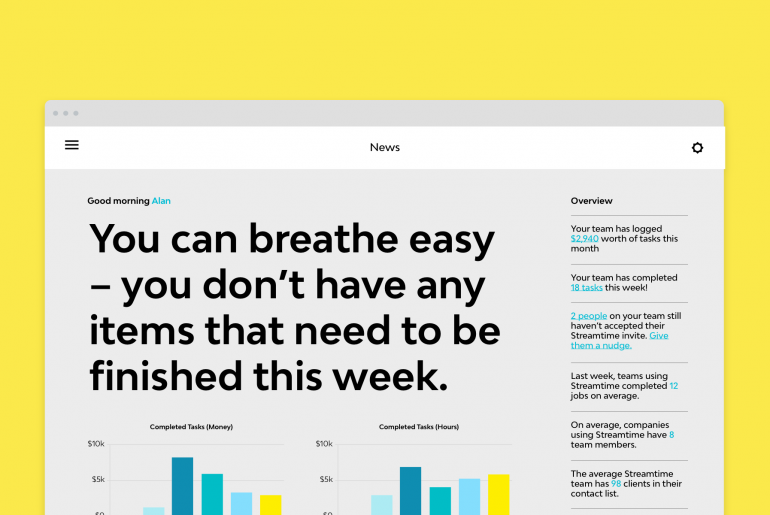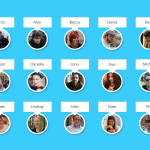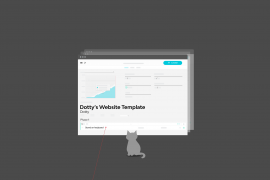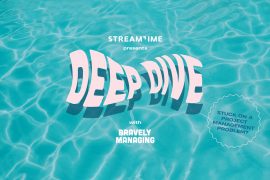
In our first blog, we shared the conclusions we came to after researching (and just generally thinking really hard about) project management. In our second blog, we talked about how those conclusions shaped our new operating ethos.
Now, it’s time to share with you our three-pronged future plan to tackle the challenges we’ve described using the philosophy we outlined.
Before we get into it though, it’s worth noting that this is our long-term plan for the future — so what we’re saying is: “we’re not there yet”. Though you may spot some early hints of this direction in the new Streamtime, we’ve still got a long way to go before we a) figure out specifically how to do what we’re talking about here; and b) are able to implement all of it.
We’re still in the laying-the-groundwork phase — but now that we’re almost done with the foundations, it’s time to start building up to our ambitious future.
Here are the three paths we’re taking to get there:
1. Future-based project management.
In every business, every day is a battle for the future. A battle to seize opportunities. A battle to keep on top of responsibilities. Frankly, a battle to keep the lights on.

Yesterday, no matter how hard it was, is always done. And tomorrow’s always filled with challenges.
So why do we put up with project management software that is almost exclusively focused on the past?
A job estimate should be the start of prediction, not the end.
It might be a strange way to think about them, but job estimates are really a prediction of the future. Of course between estimate and conclusion a lot will happen during the course of a job that will demolish that idealised vision of how a job will play out.
But what if, with a combination of small system-prompted check-ins and smart mining of existing data, the system could refine a job estimate day-by-day to provide a clear idea of how the job is actually tracking, what has changed that might affect the outcome of the job, and what those changes could lead to in the coming weeks?

It’s a shift from diagnostic analysis to prognostic analysis.
Instead of telling you what has already gone wrong, Streamtime will keep re-evaluating the variables that affect a project’s likelihood for success, and provide ongoing recommendations for course-correction.

This means analysing and constantly learning more about the factors that contribute to project completion: capacity (time, budget, people); efficiency (margins/profitability, utilisation of resources); and clearance (speed of completion, realisation of cash, team composition)… and applying that learning to future projects.
It’s important to note here that when we talk about ‘people’ and ‘team composition’, we’re not talking about treating them as statistics — after all, a senior designer will probably have a faster clearance rate than a junior designer, for example. Factoring in people requires a more nuanced approach. Which brings us to…
2. Culture management.

It doesn’t matter what industry you’re in, you’ve almost certainly read countless journal headlines and skimmed research papers all saying the same thing — we’ve underestimated the impact of culture on our businesses for too long, and we’re way behind where we should be in addressing the problem.
The businesses that most successfully handle disruption are the ones that put culture first — because they understand that it has a profound and defining impact on everything the company delivers.
The issue at the moment, though, is that culture management is often seen as a separate to project management — but the two are actually inseparable. What work is done, and how it’s done, has an undeniable impact on company culture. No amount of ping-pong tables can fix a problematic workload.
Context is key.
There are many employee engagement systems out there, ranging from the simple (basically Net Promoter Scores for employees) to the unmanageably complicated. But they exist in isolation. By building simple and intuitive culture tracking into project management, we can have the system nut out the problems for you by comparing culture metrics to events and recurring situations in the business.

Does Bob always get frustrated when he’s working for Client X? Or maybe it’s only when he has to work on that client with Gina. Does Tara just have rough, unproductive Mondays, regardless of what she’s doing? Or is it the weekend hours she’s putting in that are sapping her drive?
As with anything, the devil’s in the details. Streamtime will be able to give you the context that will turn qualitative data into genuine human insights — and help you fix any morale issues that are currently, insidiously eroding your bottom line.
Quantifying culture.
So how do you collect this cultural information in an unobtrusive way? We’re still working that out… but here are some of the factors we think should be taken into account:

– Does the team member feel like they can get their job done, and are they getting satisfaction from doing said job?
(This is probably the most important one for employee satisfaction.)

– Does the team member know what they’re supposed to be doing? Does the rest of the team know what they are doing?
(Projects go off the rails when people don’t know what they’re supposed to be achieving at any given point in time.)

– Does the team member have the resources they need to get the job done? Is there anything standing in their way?
(This is another major factor in job satisfaction.)

– How productive is the team member’s relationship with their team? What about with their clients?
Of course, these are just the start — quantifying and correlating macro cultural characteristics of your business will be difficult, and require a whole lot of data.
So how can we start pulling in that data without making your team feel like they’re working for the system? By giving them something back in return. Which brings us to…
3. Personal data.

Most software is built around what an organisation needs, not what a person needs. Every person should be able to ask the question ‘What am I getting out of this?’ when using Streamtime, and be happy with the answer.
We’ve made a start on this already (by taking away timesheets and giving people useful to-do lists), but another way we’re looking to do it is by having Streamtime collate and package the data in ways that are specifically for the team member, not the business.
Real career progression.
Part of job satisfaction is what you’re able to achieve, right? The cool things you’ve produced, or big-deal clients you’ve worked with… the awards you win, the people you win over, the raw amount of hours you put into the thing you love.
These things can be tracked… if you do it yourself. But what if Streamtime did it for you? A lot this data is being collected already — what you’re working, how long you’re working on it, who you’re working with — and the other elements (like award wins and other career achievements) could be easily logged in a personal profile. And as data correlation systems improve, we’ll even be able to track and project project, culture and skill fit for different companies.
So why don’t we do it? After all, people are obsessed with tracking and quantifying their lives. There are apps out there to help you track fertility cycles, sex lives, fitness habits, sleeping hours and countless other parts of our personal lives — but nothing that effectively does that for our work lives (other than what you might remember to put up on LinkedIn).
Take your show on the road.
This sort of career tracking is useless if it resets every time you change jobs, though — so we’re looking at creating user profiles for Streamtime that exist independently of businesses using Streamtime (which would link up with a business to share data until you part ways).
Having an independent, self-completing career record would be invaluable for full-time employees who change jobs — but imagine how useful it would be for freelancers. Whether you’re working as an independent agent, joining a team on a temp basis or even ghosting for someone else, every hour of experience you accumulated doing a particular type of work would be tracked — and potentially shared periodically to your LinkedIn profile.
This sort of company-agnostic career management is only going become more relevant, with some estimates anticipating that the freelance portion of the population in both the US and Australia will rise from 30% to 40% within the next five years.
The deep well.
The benefits of true, individual-focused career tracking run deep. It’s good for employers — because they’ll be able to get a true reflection of a freelancer’s experience levels instead of taking someone at their word and having to drop someone who is clearly out of their depth by midday. It’s good for employees, because they’ll be able to have a comprehensive and specific record of credentials built for them, refreshed every day.
Profiles could have avatars that reflect a user’s mood on the day, or their level of lifetime career achievement, or anything in between. Industry–standard badges of achievement could be introduced, with some system-defined and others peer-awarded.

Instead of saying “I worked with Industry Luminary X”, you could definitively say “I worked with Industry Luminary X on Y different types of projects for Z hours and and XX of those projects were delivered on-time and on-budget.”
A step change, step-by-step.
It’s a lot to take in. And it might sound like pie-in-the-sky thinking. But with IBM’s Watson A.I creating original recipes for meals and advising vets in animal treatment, using existing data more cleverly isn’t such a leap. And with Slack proving that radical shifts in existing processes can be made if it’s human friendly, painlessly collecting culture data doesn’t seem so hard.

And we’ve already taken our first, small steps. Streamtime’s new dashboard is already sifting through job data to pull out and elevate key insights — and it’s getting smarter every day.
By self-reflecting, iterating and updating every week, we’re getting ever closer to realising these three, intertwined visions. And every step brings us closer to project management that truly works for everyone who uses it.








